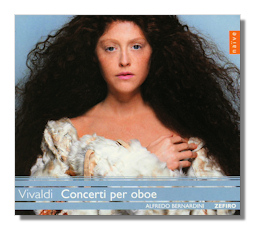
The Internet's Premier Classical Music Source
Related Links
- Vivaldi Reviews
- Latest Reviews
- More Reviews
-
By Composer
-
Collections
DVD & Blu-ray
Books
Concert Reviews
Articles/Interviews
Software
Audio
Search Amazon
Recommended Links
Site News
 CD Review
CD Review
Antonio Vivaldi

Oboe Concertos
- Concerto for Oboe in C Major, RV 447
- Concerto for Oboe in C Major, RV 450
- Concerto for Oboe in C Major, RV 451
- Concerto for Oboe in D Major, RV 453
- Concerto for Oboe in F Major, RV 455
- Concerto for Oboe in F Major, RV 457
- Concerto for Oboe in A minor, RV 463
Alfredo Bernadini, oboe
Zefiro
Naïve OP30478
Enthusiasts of the Italian Baroque in general and of Vivaldi in particular can be nearly certain that each new issue in the distinctively-presented Vivaldi Edition from naïve is going to thrill, inspire and meet even their most demanding requirements. The plan is to record all of the 450 works by the composer which are now held in the Biblioteca Nazionale Universitaria of Turin. The release of more than a hundred CDs and CD sets began in 2000 and will continue until 2015. You could be forgiven for thinking that amongst such a wealth of compositions, there were bound to be some whose shine (and hence appeal) was tarnished.
Not on this collection from Alfredo Bernadini (oboe) with the Italian wind ensemble, Zefiro! So highly thought of, in fact, were the recordings of the concerti in D Major (RV 453), F Major (RV 455) and A minor (RV 463) when first made by Alfredo Bernadini in 1994 for Astrée (E8537, nla) that they were included as part of this release instead of recording new versions. Certain qualities are needed to move performance of such music from the acceptable to the brilliant: a conscious spontaneity; complete control of the technical demands; a sense that the time and effort have been taken to appreciate the many idiosyncrasies with which Vivaldi has graced us. Above all, an empathy with the purely musical thought which drove the composer to write each movement in the way he did and in no other is required. Listen to the careful unfolding of the Allegro non molto of the F Major (RV 457) [tr.13]. None of the modulations (of pitch and pace) could have emerged from Vivaldi other than as they do. Yet the playing has to appear as though the paths taken present, if not shock or surprise, the delight of the unfamiliar. This both soloist and ensemble do admirably.
The oboe was perfected in France in the middle of the seventeenth century and was just beginning to gain acceptance in Italy as Vivaldi was growing up… in 1698 the cappella of San Marco (in Venice) appointed its first oboist; five years later Ignazio Rion was engaged as oboe teacher at the Ospedale della Pietà at the same time as Vivaldi's own engagement there. Nor was it long before the first of probably a dozen and a half (misattributions and repurposing account for the still inexact figure) oboe concerti by the composer were being written.
Vivaldi must have been well aware of the limitations of the instrument: a range of only two octaves from c'; the difficulty of performing large and/or quick intervals, leaps; and the need to allow for breathing. Yet what is required on the oboe in the seven concerti presented on this CD seems to be based on the assumption that none of this should stand in the way of the effects Vivaldi had in mind… a perfect blend of subtle grace and forceful dynamic melody; plenty of bravura coloring; intricate rhythms and changes in tempo. In these the solo instrument compounds the effects, rather than follows or "accompanies" them. Delicacy and sweetness are never far away from almost strident confidence – the Andante and Allegro molto of the F Major (RV 457) [tr.s 14,15], for example: pointed, driven, virtuosic yet restrained, retiring and unassuming. This truly is a great performance from the musicians here.
The essay in the booklet that comes with the CD goes into just the right amount of detail – in intelligently dating these works in Vivaldi's career, for example. It also emphasizes the variety of techniques, moods and sound worlds which Vivaldi creates in fewer than two dozen short movements… only the outer movements of the C Major (RV 447), like RV451 from Vivaldi's later years, are longer than five minutes. The acoustic for both sessions is clean, if a little dry; it allows each instrument besides the solo oboe (a copy after Stanesby from c.1730 by Bernadini, who also directs Zefiro) to be appreciated to the full.
If you already enjoy the depth and freshness of Vivaldi's wind concerti, you will not want to miss this CD. Equally, if you simply want to be drawn into a soloist on the top of his form, and revealing the intricacies and delights of his instrument, don't hesitate. Although the field of competitors to this repertoire is not especially distinguished, this is a series of insightful and technically brilliant accounts that will satisfy on repeated listening.
Copyright © 2009, Mark Sealey




















